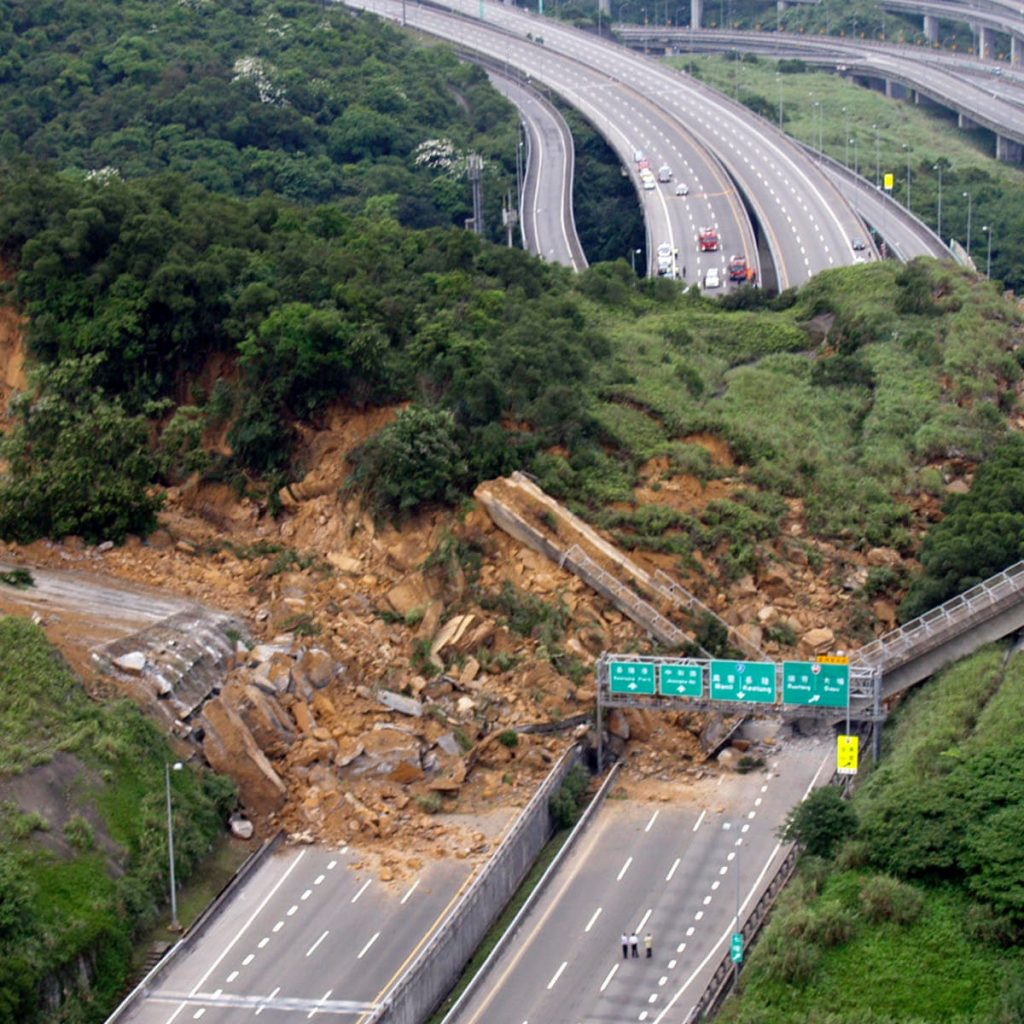What causes a landslide?
Landslides are caused by disturbances in the natural stability of a slope. They can accompany heavy rains or follow droughts, earthquakes, or volcanic eruptions. Mudslides develop when water rapidly accumulates in the ground and results in a surge of water-saturated rock, earth, and debris.
Is a landslides considered a natural disaster?
The movement of the rocks or debris etc., on a slope downwards, is called a landslide. It is a type of “mass wasting “, which refers to the movement of any mass, soil, or rocks under the influence of gravity. It is one of the natural hazards and can be a disaster if the damages occur in large amount
Type of landslides
- Landslides in bedrock
- Rock falls. Single and small rock falls from cliffs build up to form aprons of scree or talus, sometimes developing over long time periods.
- Rock slope failures.
- Rotational landslides.
- Debris flows.
- Creep.
- Solifluction.
- Translational slide.
Difference between landslides and mudslides.
Landslides are caused by disturbances in the natural stability of a slope. They can accompany heavy rains or follow droughts, earthquakes, or volcanic eruptions. Mudslides develop when water rapidly accumulates in the ground and results in a surge of water-saturated rock, earth, and debris.
Landslides are caused by disturbances in the natural stability of a slope. They can accompany heavy rains or follow droughts, earthquakes, or volcanic eruptions. Mudslides develop when water rapidly accumulates in the ground and results in a surge of water-saturated rock, earth, and debris. Mudslides usually start on steep slopes and can be activated by natural disasters. Areas where wildfires or human modification of the land have destroyed vegetation on slopes are particularly vulnerable to landslides during and after heavy rains.

Why landslide is a disaster?
If a landslide occurs near inhabited areas, it can cause a great deal of damage. They can strike quickly and bury entire villages. Buildings are damaged or flattened and roads, bridges and infrastructure can be damaged or destroyed by the debris.
Given the nature of such disasters, fast relief and rescue operations are required to get to trapped survivors but this can be delayed due to landslides cutting off easy access to the affected area. Satellites provide key observations of the area, assessing the damage and identifying areas where survivors may potentially be.
The destabilisation of ground can be caused by heavy rain and floods, seismic activity, erosion from oceans and rivers, or changes to vegetation affecting soil composition.
Who is the responsible for landslids?
Humans are responsible for landslides.
Explanation:
Deforestation of forests causes landslides. When the trees are cut down for commercial purposes, the roots of the trees rot. There is no longer ‘anything’ that is holding the soil to the ground. When there is a rainfall the soil erodes and landslides are formed.
Landslides can be caused by human and natural factors. Natural factors can include lithology, structure, slope, land cover, seismicity and rainfall precipitation, while human factors can include deforestation, improper land use and unplanned activities
How we can prevent for landslides?
Landslides can range from minor inconveniences that leave debris on your property to major accidents that can cause severe damage. Naturally, if you live in a landslide-prone area, you’d want to do all you can to protect your property. While you can’t always prevent them, there are a number of precautions you can take to lower the risk of a landslide occurring on your property and decrease the damage you’ll experience if one happens.
1.Keeping Material and Structures Away from Slopes:
A. Remove loose or heavy material from the top of the slope. Rocks, fallen trees, and other debris at the top of a hill can put your property at risk for a landslide. Clean off all the slopes on your property to remove material that might come loose. Move this debris away from the slope, on the base, or off your property altogether. You might need a professional with heavy equipment to remove heavy rocks and soil. Consult a contractor on hauling away heavy material like this. Be courteous to your neighbors when you relocate this material. Don’t put them in a place where they could slide onto your neighbors’ property.
B. Build sheds or other structures away from an edge. If you’re planning a new shed or similar structure, keep it far away from the edge of a slope. Consult an engineer to tell you what a safe distance from the slope is and follow that advice before you start building.
There isn’t a hard rule on how far structures should be from the slope. It depends on the soil, drainage, slope, and how prone the area is to landslides.
2. Controlling the Water on Your Property:
A. Fix any leaks in your pipes or drainage system. Leaks in your water system can gradually erode the soil under your property. Have a professional go through your pipes and make sure there are no leaks. If they do locate leaks, fix them right away.
There are a few signs that you might have a water leak. These include an unusually high water bill, a musty smell in some areas of your home, or puddles on your property when it hasn’t rained recently.
Remember to check your outdoor water lines as well, like your hose, pool, and sprinkler system if you have one. Leaky pools are a particular cause of gradual soil erosion.
B. Install flexible fittings to prevent your pipes from breaking. Flexible fittings won’t crack, which helps prevent water leaks. Use these fittings at turns and angles in your pipe system so your water lines are more resilient.
Installing flexible fittings is similar to installing regular pipes. You can do it yourself if you feel confident, or have a plumber do the job.
Flexible fittings are especially useful in areas prone to landslides because they’ll resist breaking if there’s a shift in the ground.
You can use flexible fittings in your gas lines as well. This is a dangerous job that could cause a gas leak if it’s done incorrectly, so don’t do it yourself. In some areas it’s even illegal to work on gas lines by without a license. Have someone who works for your gas provider make this adjustment.
C. Make sure your drainage system leads directly to the base of the incline. If you have a downspout or similar drainage system to carry water away from your home, make sure it runs all the way to the bottom of the slope. This stops the water from pooling or running down the slope and loosening the ground.
You might not be able to drain the water all the way to the bottom if the base is further than your property goes. Instead, make sure your system flows into the nearest storm drain or a natural runoff area.
Make sure the water drains far away from your neighbors as well. You wouldn’t want them draining their water onto your property.
3. Strengthening the Ground:
A. Remove loose soil and replace it with more dense material. Over time, soil can erode and grow more prone to landslides. Speak with a contractor about replacing your topsoil with denser, sandy soil that’s more tightly-packed. This can help make the land on your property more stable.[8]
This is a professional job that requires machinery and equipment. Don’t try to do it on your own.
Do not push any old material back up the slope or towards the edge. This increases the landslide risk.
Take other measures to protect the soil besides replacement. Over time, the new soil will erode as well and become landslide-prone without other steps.
B. Build a retaining wall at the base of a slope to protect your home. If you live in a landslide-prone area or at the base of a hill, then this is your best chance for protection. Extend the wall for the entire length of your property for the best protection. A reinforced retaining wall with metal spikes drilled into the ground rock is the best method to guard against landslides. The footing should be behind the wall and as wide as the height of the wall. This can prevent landslides or divert the flow away from your home.
If you build a wall, putting drainage behind the wall is extremely important. This will prevent the wall from tipping over and sliding down the hill if any pressure buildup or water accumulates in front of it.
C. Plant trees and shrubs on hills to keep the soil packed and protected. Vegetation protects the soil from erosion and prevents landslides. If the slopes on your property are bare, try planting some plants with thick or deep root systems. Good choices are trees, shrubs, and tall grasses.[10]
If the slope already has plants on it, do your best to protect. Don’t cut down trees or pull up shrubs without replacing them.
If you have to remove some vegetation because you did landscaping work, then get new plants as soon as possible to prevent erosion.
If the slope is on your neighbor’s property, talk with them to see if they’ll grow some plants on it. Offer to help pay for it to convince them.
D. Dig a ditch to divert landslides away from your home. Even with other preventative measures, landslides can still happen. In this case, you can still protect your home with a ditch surrounding your property. This can capture or divert the debris to another location, protecting your home.[11]
Consult a contractor for this job. It requires a lot of technical knowledge and equipment to build a proper ditch.
Make sure the debris is redirected to a vacant area. If your ditch redirects debris to flow onto a neighbor’s property, you could be liable for damages.
